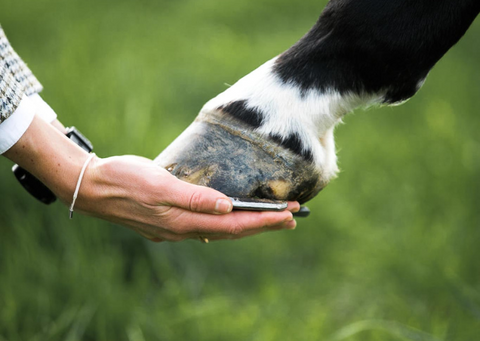When your horse or pony has laminitis, he or she suffers from a painful inflammation of the tissue between the hoof wall and the coffin bone. The disease can be life-threatening for your four-legged friend—so quick intervention is a must. This is how you help a horse with laminitis.
1. Involve your veterinarian right away
First up on the agenda: getting the pain under control. Laminitis is very painful for a horse, which makes it a medical emergency.
Your veterinarian will take x-rays to assess the position of the coffin bone (the third phalanx) and estimate the severity.
If your horse is over twelve years old, it is best to request a blood test as well—just so you can rule out PPID.
2. Put your horse on soft soil
To create soft ground, it’s best to use sawdust, wet sand or wood shavings. If you put your horse on sand, make sure that he or she does not eat the sand—sand colic on top of laminitis is not the way to go.
Support the hooves with special hoof boots, and don’t try to move your horse too much as long as walking independently is hard.
3. Cool your horse’s feet
Lowering the temperature is how you reduce inflammation and swelling of the tissue in the hooves (the ‘laminae’, as the layers of tissue are called).
Put some ice cubes in a plastic bag and hang them around your horse’s feet.
If you don't have ice cubes, spray the hooves with cold water.
4. Avoid sugar
Take your horse away from grass pasture (with extra support for the hooves), eliminate grain from the feed and switch to a low-sugar diet.
This is different from fasting, though. When horses or ponies suddenly get no food, their body will use their own fat tissue as a source of energy. That’s bad news, because when those fats are released, they end up in the bloodstream and that will result in a fatty liver.
So keep feeding hay, but make sure the hay is low in sugars as well. If you want to lower the sugar content in the hay, soak it in water. Are you dealing with a gluttonous horse? Give him or her the hay in a hay net or slowfeeder.
5. Useful herbs and minerals
Pamper your horse with the right herbs and minerals. Choose a herbal mixture that acts on the various aspects of hoof health: liver support, blood circulation in the hooves, protection of the stomach and intestines, a balanced fat and sugar metabolism...
Here are a few useful minerals and herbs for afflicted horses:
- Magnesium works wonders for stiff muscles and supports sugar metabolism by promoting a normal insulin response. Chlorella, for example, has high magnesium content [1].
- Chlorella is abundant in chlorophyll, which closely resembles hemin, the component that forms hemoglobin. This similarity makes it beneficial for increasing red blood cells and enhancing oxygen supply [2].
- Equisetum is rich in silicon, an important building block for healthy hoof tissue [3].
- Liquorice supports stomach health and promotes normal cortisol metabolism in the body [4].
- Chrysanthellum americanum and Silybum marianum (and no, these are not magic words from Harry Potter) support the liver [5].
- MSM supports the natural defense and is rich in sulphur, an important building block for healthy hooves [6].
- Pinus pinaster and L-arginine promote blood circulation in the hooves [7].
- Berberis vulgaris supports the metabolism of fats in the body [8].
Overwhelming? Don't panic! You can contact us via live chat or email us at , and our veterinarians will assist you.
6. Hoof care
A must in the case of laminitis: protect the hooves and adjust your horse’s position. In the first phase, it is important to prevent the tilting of the coffin bone. This will relieve the pain on the hoof wall.
After that, the farrier tries to approach the natural situation of the hoof as closely as possible by trimming it. Are you looking for a farrier with a great deal of experience with horses that suffer from laminitis? One name: Remco Sikkel.
7. Adapted movement
Sufficient exercise is important in the full recovery of laminitis, but never in the acute phase. At that stage, movement will increase the chance of tilting the coffin bone, which is often too painful for your horse.
- Step one: getting the pain and swelling under control.
- Step two: move.
It goes without saying: is no picnic for your four-legged friend. So it is . And if you do have to deal with an afflicted horse or pony sooner or later, apply the tips above. Then you will keep the consequences well under control.
Scientific References
- Winter J. C., et al., (2020) Relationship between intracellular free magnesium concentration and the degree of insulin resistance in horses with equine metabolic syndrome. Pferdeheilkunde 36, 325–332; DOI 10.21836/PEM20200406
- Rani K., Sandal N. & Sahoo PK, (2018), A comprehensive review on chlorella- its composition, health benefits, market and regulatory scenario, The Pharma Innovation Journal, 7 (7), 584-589.
- Smita Badole & Swati Kotwal, (2014), Equisetum arvense: Ethanopharmacological and Phytochemical review with reference to osteoporosis, 4 (1).
- Peyman Petramfar, et al., (2020), Efficacy of oral administration of licorice as an adjunct therapy on improving the symptoms of patients with Parkinson's disease, A randomized double blinded clinical trial, Journal of Ethnopharmacology, Vol 247.
- Xiang Li, et al., (2023), Effects and mechanism of action of Chrysanthemum morifolium (Jinsi Huangju) on hyperlipidemia and non-alcoholic fatty liver disease, European Journal of Medicinal Chemistry, Vol 255.
- Applied equine nutrition, Equine NUtrition Conference (ENUCO) (2005), Editor A. Lindner, Pages: 172.
- Siani A, et al., Blood pressure and metabolic changes during dietary L-arginine supplementation in humans. Am J Hypertens. 2000;13(5):547-551. doi:10.1016/s0895-7061(99)00233-2
- Wang H, et al., (2018), Metformin and berberine, two versatile drugs in treatment of common metabolic diseases. Oncotarget. 2018;9(11).



